TYPO3 v14.0—We're just getting started

The first sprint release of the TYPO3 v14 series represents a major milestone and is now available for you to download. It marks the beginning of a new era for the open-source content management system TYPO3. The backend received several strategically designed changes which lay the foundation for future innovations—and we’re just getting started.
We are excited to announce the release of TYPO3 version 14.0. More than 2,000 changes, small and large, have made it into the code repository since development officially started more than a year ago. A big thanks to everyone who contributed to the open-source project.
We’ve taken a bold step in restructuring and renaming several modules in the left-hand side menu of the TYPO3 backend. The DocHeader has also been reworked and now features an interactive and responsive breadcrumb menu.
But TYPO3 version 14.0 is more than just backend adjustments. The first version in a new release cycle always involves a significant round of clean-up and modernization. The removal of deprecated elements aims to modernize the internal architecture and sets the stage for new features and innovations in upcoming releases. For example, one of the modernization tasks include an upgrade of the Fluid templating engine to version 5.
Let’s have a closer look at the main changes of the new release. For more in-depth information with detailed technical insight, see the v14.0 changelog.
Key Changes in TYPO3 Version 14.0
A New Era of Backend Usability Starts Now
The TYPO3 backend is the interface where editors, integrators, and administrators log in to maintain the website’s content, configure the system, and manage translations. Due to its central role, we constantly improve this area with every TYPO3 release, and adopt emerging technologies to keep the backend up-to-date, fast, and easy to use for everyone.
New users can sometimes feel overwhelmed by the broad range of functions, modules, and interface elements TYPO3 provides. This learning curve needs to improve. Our goal is to redesign the TYPO3 backend with the upcoming TYPO3 v14 releases so it offers a more intuitive and user-friendly experience. The layout, structure, and available functions are being refined to help even first-time users quickly understand the core UX concepts and the purpose of each feature.
Importantly, experienced users will not need to relearn the entire system. The focus is on visual refinement and modernization rather than creating an entirely new backend. With the upcoming TYPO3 v14 releases, we will introduce significant UI and UX improvements that lift the experience of working with TYPO3 to a new level.
This work is guided by the TYPO3 v14 roadmap, where objective 1 is all about a modernized backend with a fresh, user-friendly design. The roadmap frames the overall direction: more intuitive navigation, consistent terminology, and a visually polished interface.
One visible step in this direction is the renaming of backend modules in the left-hand side menu. We thoughtfully compared the name of every module and submodule with its function, while also considering terminology commonly used in other content-management and digital-asset-management systems. As a result, several modules have been renamed to better reflect their purpose:
- “Web” now reads Content
- “Files” now reads Media
- “Admin Tools” now reads Administration
In addition to renaming, we restructured, regrouped, and moved modules to create a more logical workflow.
The Reports module now uses TYPO3’s native submodule system to provide a consistent user experience, and a new module Administration → Integrations serves as the central hub for connecting TYPO3 with external systems and third-party services.
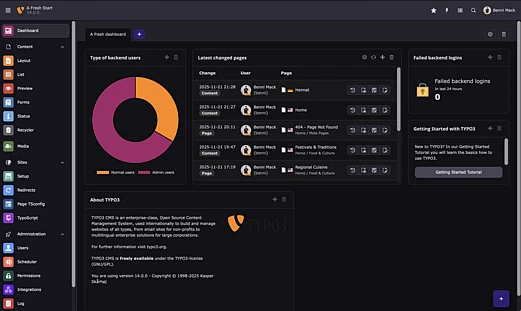
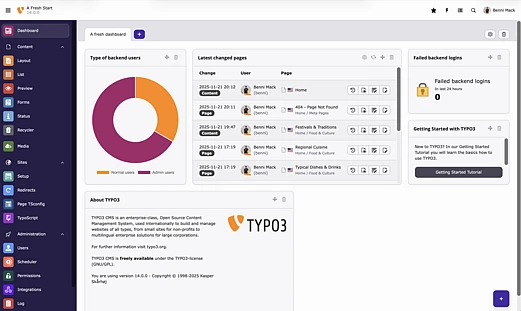
The document header (also known as the DocHeader within each module) has been redesigned to provide a more consistent and intuitive user experience across all backend modules. The logically structured layout now features breadcrumb navigation and unified language selector for all backend modules with multi-language support.
The second row is reserved for action dropdowns and a range of buttons such as “save”, “close”, “reload”, “bookmark”, etc.
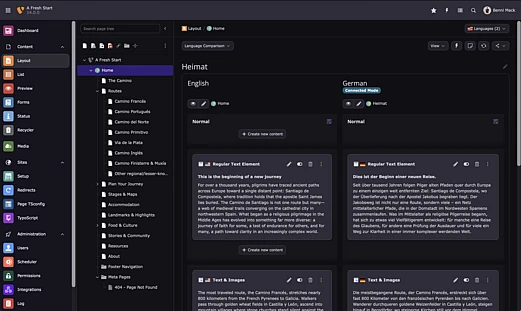
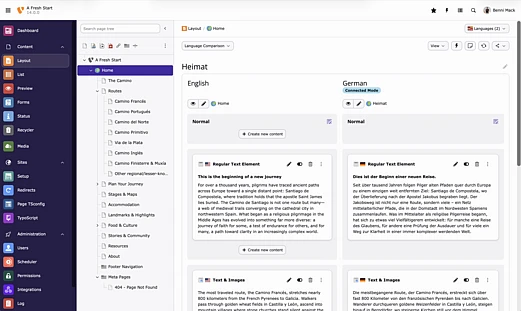
TYPO3’s reference index has become increasingly important for administrators since the improvements in TYPO3 v13. The reference index is a critical system component that tracks relationships between records in TYPO3. Checking and updating has become a routine maintenance task for administrators, and therefore, we moved its backend module to the Install Tool section. This positions it alongside other common maintenance tasks such as the database schema checks, cache management, and folder structure checks.
The Database Relations backend module has been removed, since this function was rarely used and provided limited value.
We understand that experienced TYPO3 users may need a moment to adjust to the new names and structure. With a little time, you’ll find the changes intuitive and consistent, helping to create a smoother workflow for both long-time TYPO3 enthusiasts and newcomers.
The Next Generation of Fluid
TYPO3’s default template engine, Fluid, has been a core part of the CMS for many years. Its success story continues in TYPO3 v14 with an upgrade to Fluid version 5. This new version brings cleaner, modernized code, a simplified cache warmup process, and stricter type handling for ViewHelpers — making development more predictable and robust.
Flexible Template File Names
We have also reworked how Fluid automatically resolves paths to layout and template files. The long-standing requirement for file names to begin with an uppercase character has been removed. Instead, Fluid now uses a flexible fallback chain that first searches for files using their standard spelling and falls back to the uppercase variant if necessary. This improvement not only simplifies file handling but also allows us to introduce a dedicated file extension for Fluid templates, such as *.fluid.html, *.fluid.txt or similar in the future. Due to the fallback chain, the new file extension is optional and existing templates will continue to work.
CDATA Support
Developers who have struggled with using inline CSS or JavaScript in Fluid templates will be pleased to learn that these challenges are now a thing of the past. Fluid version 5 fully supports CDATA sections, allowing you to include raw styles and scripts without conflicts caused by curly braces. Content within CDATA sections is ignored by Fluid’s parser, while variables, ViewHelpers, and expressions can still be used with triple curly braces “{{{ }}}” for greater flexibility and clarity.
New ViewHelpers
Apart from the upgrade to Fluid version 5, TYPO3 v14.0 comes with several new ViewHelpers.
- A new PageTitle-ViewHelper makes it easier than ever to set page titles directly in Fluid templates. Extension developers can now generate dynamic page titles without creating a custom Page Title Provider for each extension. This enhancement greatly simplifies scenarios such as Extbase detail views, where the page title should automatically reflect the displayed record. By handling this logic directly in Fluid, developers can maintain cleaner code with fewer dependencies.
- The new PageMeta-ViewHelper allows meta tags to be set directly through TYPO3’s MetaTagManager API. Being able to influence page attributes from within Fluid is especially valuable for frontend developers because it reduces or removes the need for custom TypoScript.
- Custom PageHeader-ViewHelper and PageFooter-ViewHelper. Two new ViewHelpers let developers inject custom content into the HTML <head> section, or just before the closing </body> tag of a rendered page. These new capabilities provide more flexibility for integrating scripts, metadata, or other elements dynamically.
- The Date-ViewHelper has been enhanced with a new “timezone” option. This addition allows TYPO3 integrators and developers to render dates and times in a specific time zone directly within their Fluid templates. It’s a simple but powerful improvement that provides greater flexibility for displaying localized or context-specific date and time information without requiring additional code.
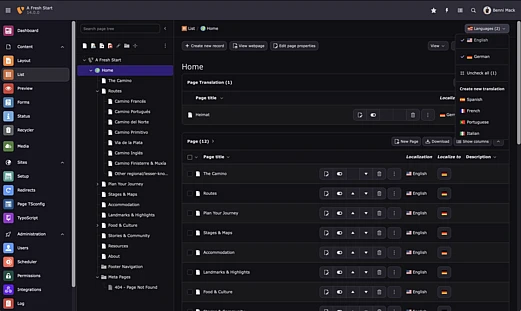
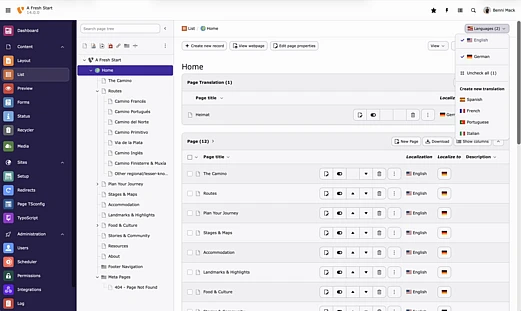
Localization and Translation
New Guided Translation Workflow
➊ TYPO3 provides powerful tools for creating and managing multilingual websites and has long been designed around an effective translation workflow. In TYPO3 v14.0, a modernized approach replaces the previous localization system with a guided, step-based wizard that leads editors through each stage of the translation process.
When a translation is initiated anywhere in the backend, the new wizard opens, ensuring a consistent workflow across all modules. It advances through the necessary steps and skips those that require no input, so editors focus only on the decisions that matter. This creates a clearer and more intuitive experience, with structured guidance tailored to the task at hand.
The new translation system also lets extension developers integrate custom localization handlers, including connections to external translation services or AI-powered tools.
Improved Language Selection in the Backend
➋ Switching between languages, and choosing which ones an editor or translator wants to work with, is now simpler than ever. Backend users can select multiple languages at once, hide or show individual languages, and quickly enable or disable all available options. Their selection is retained across both the Page and List modules, ensuring a smooth and consistent experience when moving between views.
Modernized Localization Architecture
Although TYPO3 offers exceptional multi-language capabilities compared to other open-source content management systems, its underlying handling of translation labels has become outdated.
As a consequence, several changes in TYPO3 v14.0 affect TYPO3’s localization system, which we migrated to use the Symfony Translation component. Apart from standardized methods of parsing XLIFF files, developers can leverage custom translation loaders following Symfony standards, and TYPO3 now supports both XLIFF 1.2 and XLIFF 2.x translation file formats.
The Symfony standard also allows integrators and developers to reference language labels in a more logical and flexible way. Translations can be organized into groups called “domains”. The following example demonstrates how straightforward a reference can be, using the new domain syntax:
- OLD: “LLL:EXT:core/Resources/Private/Language/Form/locallang_tabs.xlf:general”
- NEW: “core.form.tabs:general”
Rest assured that you don’t need to update all your TCA files if you want to upgrade your site to TYPO3 v14. We will maintain backward compatibility while providing a modern foundation ready to be used today and far into the future.

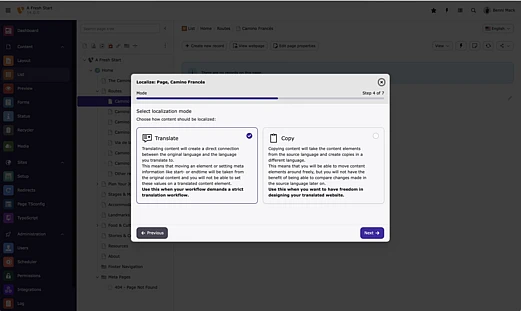
TYPO3 Under the Hood
Housekeeping
The first version in a new release cycle always involves a significant round of clean-up and modernization. In TYPO3 version 14.0, we removed deprecated PHP classes, functions, CLI calls, and other components that had been retained for legacy compatibility. This housekeeping step ensures a cleaner, leaner, and more maintainable codebase.
The removal of deprecated elements in accordance with our deprecation policy not only modernizes the internal architecture but also sets the stage for new features and innovations in upcoming releases.
The change log entry “Deprecated functionality removed” provides a comprehensive list of PHP classes, methods, properties, TypoScript options, and other functionality that have been removed or changed. Follow the links to the “Deprecation entries” to learn more about migration options for each change.
System Resource API
The code responsible for resolving various resources and generating URLs is now encapsulated in a System Resources API in one central place. Resources in this context can be:
- Files located in an extension (package resources)
- Assets stored and managed in TYPO3’s File Abstraction Layer (FAL)
- Files located in the TYPO3 project folder (app resource)
- URI resources.
The new System Resource API resolves the location of resources by keywords such as “PKG” or “FAL” consistently across all areas of the TYPO3 Core (in PHP code, TypoScript, Fluid templates, etc.). All places in TYPO3 Core where URLs are generated from specified resources have been adapted to use the new API. The legacy “EXT” keyword remains intact for the time being.
The clear benefit: TYPO3 now resolves resources consistently throughout the entire system. The System Resources API is easy to use and helps developers avoid making mistakes that could result in security vulnerabilities. Due to its flexibility, the API can be extended, for example, to deal with resources stored in nodes of a content delivery network (CDN).
Annotations and Data Validation In Extbase
Extbase, the programming framework used by TYPO3, has also received several updates and improvements. One focus area is the use of annotations to validate data passed to models, controller actions, and data transfer objects.
In TYPO3 v14.0, Extbase no longer relies on the third-party library doctrine/annotations which is not maintained upstream anymore. Since PHP 8.2 is now the minimum requirement for TYPO3, developers should migrate their implementations to PHP attributes. TYPO3 has supported attributes for all Extbase-related annotations since version 12.
A second important change relates to Extbase validators. Extbase models and controllers now support Symfony Validators. Symfony offers a wide range of validators out of the box. Combined with the validators already available in Extbase, TYPO3 developers now have access to more validation options than ever.
Together with the PHP attributes described above, input validation has become considerably easier and the need to create custom validators has been greatly reduced.
Hosting and DevOps
It is now possible to store Install Tool sessions in data storages such as Redis or to define a custom storage path for file-based sessions. This enhancement makes session handling more flexible, especially in distributed or containerized environments. It improves scalability and gives administrators greater control over how Install Tool sessions are handled.
A further improvement directly relates to the Redis cache backend. TYPO3 now supports authentication using both a username and a password when communicating with a Redis server. This aligns with the authentication model introduced in Redis version 6 and makes integrations more secure.
Automated deployments and scripted installations are now easier and straightforward since the Install Tool password hash can be generated through the TYPO3 command-line interface (CLI). No more manual file edits required! The command supports both interactive and unattended usage and improves the overall workflow when preparing new TYPO3 environments or adjusting existing systems.
The TYPO3 Core no longer performs HTTP response compression for frontend or backend output. The previous configuration options that controlled compression have been removed in TYPO3 version 14.0. Modern servers typically provide more efficient compression algorithms and negotiate directly with clients, which prevents duplicated effort and avoids possible conflicts.
Since the Install Tool is now fully integrated with TYPO3’s backend routing system, the standalone file “typo3/install.php” is no longer required. As a consequence, Composer-based TYPO3 installations do not need the “typo3/” folder anymore. System administrators do not need to take any action as full backward compatibility is maintained.
Finally, the default “.htaccess” template delivered with TYPO3 for Apache web server environments has been updated. The revisions take the folder structure used by modern Composer-based installations into account. The new version acknowledges the current asset structure and helps ensure that requests are routed correctly. Administrators of existing installations are encouraged to review their .htaccess files and adjust them as necessary to align with the new template.
System Requirements, Support, and Maintenance
TYPO3 v14 requires at least PHP version 8.2 which will receive security updates until 31 December 2026. TYPO3 v14 also supports PHP versions 8.3, 8.4, and even the latest 8.5, paving the way far into the future.
When upgrading from a previous TYPO3 version, you can rest assured that the upgrade experience of the TYPO3 Core will be smooth. TYPO3 v12, v13, and v14 all have similar minimum system requirements. TYPO3 v12 and v13 support PHP version 8.2 and the MariaDB and MySQL database engine versions are also supported by TYPO3 v14. This means that you can update the platform first, followed by the TYPO3 instance.
We will support each TYPO3 sprint release (v14.0 to v14.2) until the next minor version is published. The long-term support version TYPO3 v14 LTS (aka version 14.3) will receive bug fixes until 31 December 2027, and we will provide security patches for TYPO3 v14 LTS until 30 June 2029.
Read more about the requirements and dependencies on get.typo3.org.
Download and Installation
You will find all the details about the release and how to download and install TYPO3 at get.typo3.org. Detailed installation instructions are documented in the Installation Guide. We recommend using Composer to set up your TYPO3 environment.
What’s Next
TYPO3 version 14.1 is the second sprint release of the v14 series, scheduled for 20 January 2026, and there’s plenty to get excited about.
We will continue to modernize the backend user interface. This task has a top priority and we are eager to get it right. New API endpoints are planned for this release, and we’re also aiming to build a default theme out of the box, built on the concepts of Site Sets.
